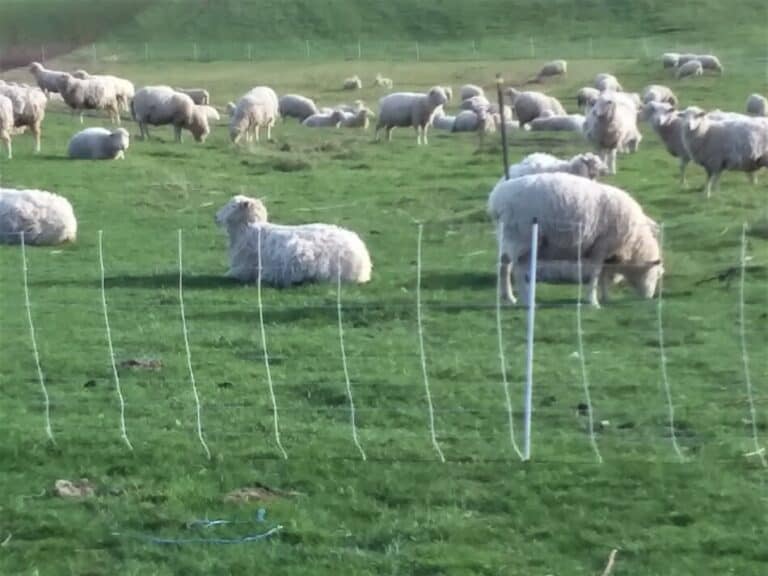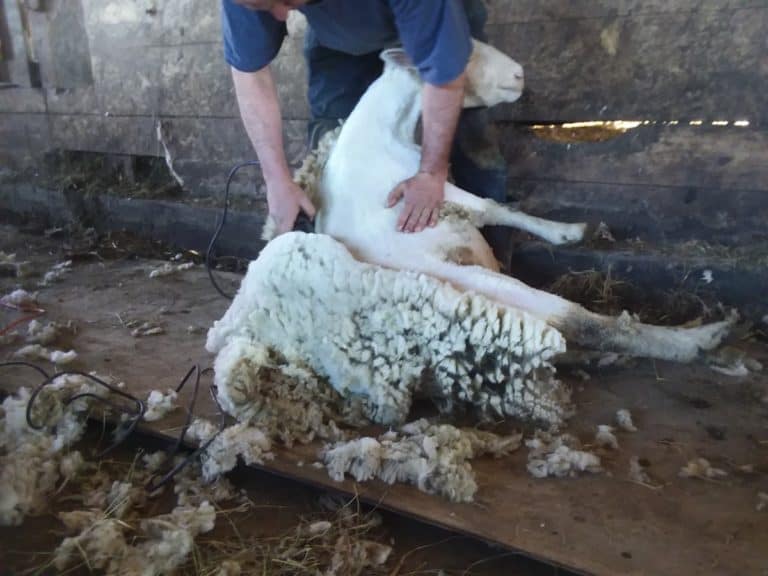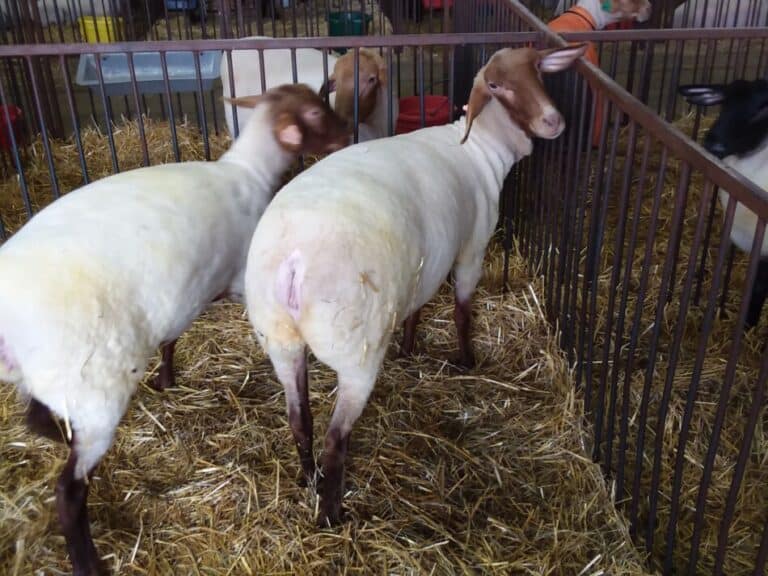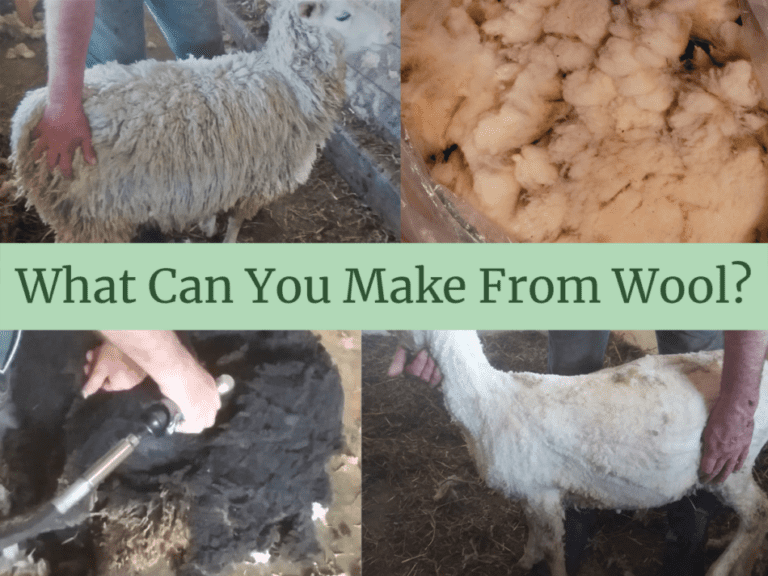8 Things You Should Not Do Around Sheep

Whether you are new to raising sheep or regularly hike or bike by a flock, it’s important to know a little bit about how to act around the sheep to keep both you and the sheep safe and happy.
Since sheep react to things differently than we do, it can be confusing to understand what to do and not do around the flock. What are some of the things you need to avoid doing when you are with sheep?
Is Raising Lamb For Meat Worth It? is an article I wrote giving a budget for buying and raising your own freezer lambs.
Do not have dogs around sheep
The biggest mistake well meaning people make around sheep is to take their dog on a walk and plan on the dog staying with them rather than chasing sheep. Sheep chasing, also called worrying, is a growing problem.
Your pooch will leave you and chase those sheep in a second. The way sheep move is very attractive to dogs and brings out their hunting instincts.
Your dog is not being bad, he’s having “fun” but that fun is harming the sheep. But…that doesn’t matter since the sheep are paying dearly for your dog’s entertainment.
Sheep are very sensitive to stress. Being chased by dogs is stressful. So stressful, in fact, that all this chasing can cause miscarriages in bred ewes or death to lambs from trampling or older sheep due to heat exhaustion.
The catch here is that you may not see these results for a few hours or a few days after the chasing is over. Meaning you think your dog was just out there messing around, but there was no harm done. Not so.
That bout of chasing will be paid for by the sheep and their owner in health consequences and lost revenue. Keep your dog well away from sheep. You don’t want him to get into the habit of chasing!
Avoid moving or working with sheep in the heat
Sheep do not handle heat well, especially if it is humid and hot. If at all possible, move your sheep during the cooler part of the day or move them another day.
I know certain management activities have to be done on a schedule and sometimes the weather does not cooperate with you. Do what you can to ease the stress of the flock by moving or working them in cooler weather.
For instance, we deworm the lambs at least twice during the summer. We have a plan and try to get the sheep rotated up to the barn to be close to the working chute and sorting pen.
However, sometimes the weather does not cooperate with us and we get the sheep up to the barn in a hot spell. So, how do we handle this?
We either adjust the grazing to keep the sheep close to the barns for a bit longer to wait out the hot weather, or we make sure to work the sheep in the early morning and be done with deworming well before the heat of the day hits.
It’s better for the sheep to adjust our management schedule than to insist upon working the sheep on the hot days.
Read Signs and management of heat stress in sheep by Richard Smith, Agriculture Victoria for more details on heat stressed sheep and how to best manage you sheep in the hot weather.
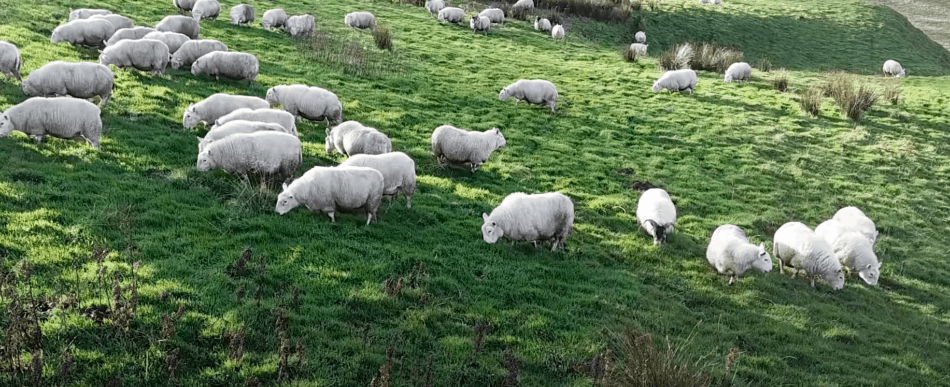
Do not go through a flock, go around
In our part of the country, Ohio, we do not have outdoor enthusiasts walking through our sheep, but the rangelands of the western part of the country and other countries do.
Please do not mess around with sheep that are not yours! The sheep you are coming across in your adventures are someone else’s livelihood.
If you do come to a flock in your travels, go around them or turn around and try another path.
This isn’t just about the sheep, it’s also about the guardian dogs that are likely to be with the flock. The job of the dogs is to keep potential threats away from their flock, you are a potential threat.
Make the both the sheep and the dog’s life easier, and yourself safer by turning back and rerouting your path.
Avoid loud noises around sheep
Sheep do not respond well to loud noises, generally loud noises scare the flock. Loud noises could come from shouting or your activities, including vehicles (even small ones like 4 wheelers).
Sheep will get used to a noise that happens repeatedly near where they are grazing, like a car going past on the road. But loud or sudden noises will scare the sheep, causing them stress and confusion.
Avoiding loud noises around sheep ties in with the not moving sheep in the heat.
Even if you are not meaning to harass the sheep with what you are doing, if they run away in the heat because of something you were doing, you are causing the flock unneeded stress and hardship.
If you are moving or working with sheep and are planning to use noise as an aid to get the sheep headed in the right direction, start off a bit softer than you think and see what your results are.
By starting softly as you can while still getting sheep movement, you are keeping the sheep calm and they will be easier to work with when you and the sheep get where you are going.
Scaring the sheep buy being unnecessarily loud will actually make the flock harder to work with, so your task of moving the flock will take longer than if you had started out more softly.
Usually I walk up to the sheep, to get them to move. If that doesn’t work I use a hissing noise and waive my arms a bit. It doesn’t take much to get them going. No loud noises required.
Do not be in a hurry when working with sheep
Again, all of these points work together and this is a biggie. The fastest way to work with sheep is actually by going slow and using the least pressure (from your movement or noises) that you can to get results.
Once sheep get scared they get “heads up” or high strung, understandable since they are feeling threatened and worried. Heads up sheep will overreact and make your planned activity more difficult.
The sheep are not being difficult on purpose, they are just acting rather than thinking because they are scared. And remember, why are they scared? You went to fast for them.
Slow down. If you can, stop working with them completely. Give them time to get a little calmer, then proceed. Next time start out with less pressure and you’ll actually get the sheep where you want them to go more quickly.
How do you know how much pressure sheep need to move but not be scared? All you have to do is pay attention to how they react to you.
Go up to the sheep you want to move, approaching from the opposite site of where you want them to go. Walk slowly. As soon as they look at you stop. Give them a chance to move. If they don’t move, take a step or two forword and stop.
Keep applying pressure (the pressure is coming from you being close to them) to the sheep until they start to walk away. If they run away, you came on too strong!
Moving sheep will go better if they have been through the area before and there are no distractions or objects blocking the way.
Even something like a car parked in the driveway (that they have plenty of room to walk around) will cause them to slow down and think about going another way rather than walking past.
Herding Sheep On Foot goes over how to move your flock when you do not have a trained dog or bucket trained sheep!
Do not assume sheep are dumb or unthinking
Sheep are acting or reacting to something for a good reason. Often times sheep get the reputation for being dumb when what they really are doing is overreacting.
I don’t mean that sheep will react to things the way you would, they can’t since sheep do not have your reasoning ability. If you consider what’s going on from the point of view of the sheep you may see things differently.
Think about it, if you can change how you behave towards the sheep and the sheep are all of a sudden moving well and acting “smarter” did they really get smarter in the past 30 seconds? Of course they didn’t!
All that happened is you changed the situation to something that the sheep find acceptable and the sheep gave you different results. Really what happened is you got a bit smarter and more capable as a shepherd!
So, what do you do with this information? Change how you work with the flock to get the results you want, which might just be avoiding the results you don’t want!
Don’t get me wrong here, I get frustrated with our sheep when things do not go as planned. But I have to admit, if I think back over what is frustrating me, it is usually my mess up in either planning or facility set up.
Avoid gathering sheep with small lambs
If at all possible, do not tightly gather or pen up the sheep when the lambs are small. By gather, I mean put the sheep in a pen in close quarters so you can catch them.
What happens is the ewes are scared and running around the pen trying to get out. While they are running around, the lambs are tying to keep up but instead are getting stepped on and hurt.
Sometimes the lamb just get knocked down, other times they get severely injured. All of this is an accident, of course. The ewes did not hurt the lambs on purpose, but the lamb is hurt and this is your problem to deal with.
The best way to avoid injuries to young lambs is to not push the ewes into tight areas where trampling lambs is likely to occur.
Sometimes you need to catch the sheep or just one or two ewes, if they have young lambs, go carefully here.
We do our best to never gather sheep with young lambs, due to the trampling that can happen in the catch pen. Think over what you are doing and consider a different approach rather than risking your lambs getting hurt.
To be clear, just moving the sheep to a new pasture is fine, as long as you go slow and allow for the lambs to catch up after initially lagging or allow the ewes to go back and get their lambs after they eat.
If for some reason you have to trailer the ewes with lambs, have a lamb only area and a separate ewe only area. Transporting them together in the same section of the trailer will risk hurting the lambs.
Do not leave small children with sheep
Sheep are normally friendly and pretty safe to be around, but they can get to running and knock over smaller kids. Especially if the child is in the doorway that the sheep want to run through to get back out to the pasture.
Additionally, rams can be pushy and shove or even headbutt children. A ram can easily knock down an adult, so be careful here.
